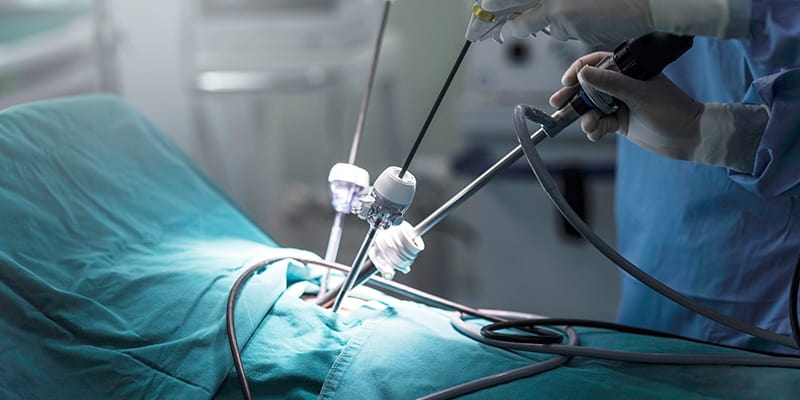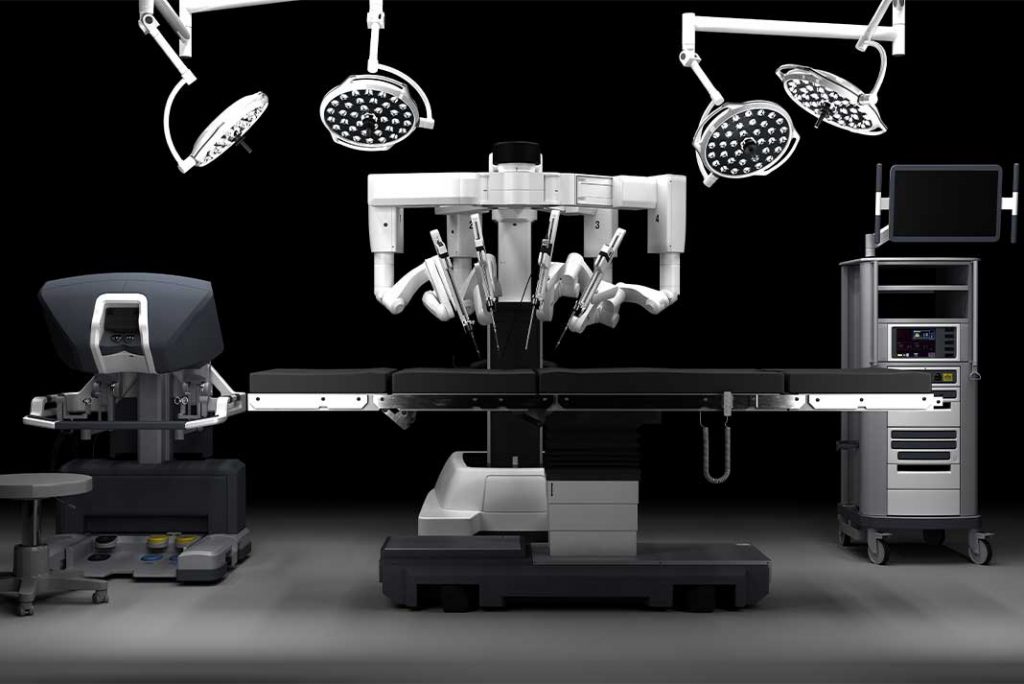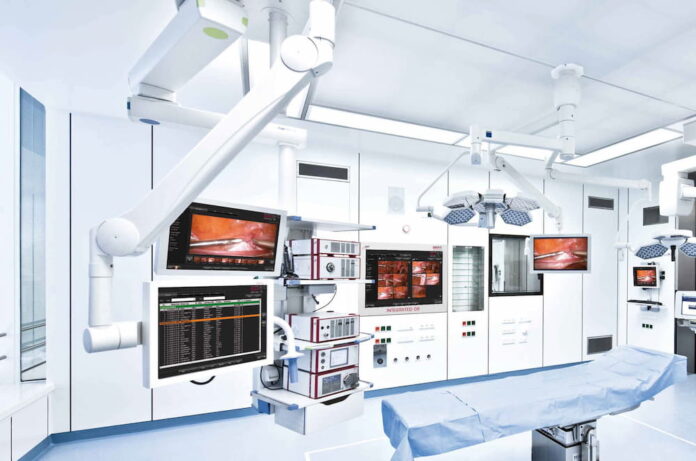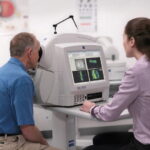Digital operating rooms allow direct transmission of surgical procedures in international medical forums and conferences. The digital work within the operating rooms contributes to making surgical decisions quickly and also reflects positively on the patient’s health by helping him receive the appropriate treatment at the ideal time.
As for the design of this type of operating room, it is carried out according to the highest international quality standards and special specifications such as isolating walls and floors with bacteriostatic materials, in addition to providing special air-conditioning systems equipped with air filters to purify with high accuracy, as well as a special system for the disposal of harmful anesthesia gases, and another system that isolates rooms from the outside air. Digital operating rooms are equipped with LED light technologies that help the surgical staff perform their work to the fullest.
Today, digital operating rooms are provided with direct transmission techniques on the Internet so that the process can be transferred directly in medical conferences and seek other medical opinions from anywhere in the world, which is an important feature for the patient because it saves the trouble of traveling for diagnosis and medical advice with obtaining another medical opinion without forgetting the speed of his recovery and his discharge from the hospital after a day or two and return to his work and his normal life.
The digital operating rooms are designed in a way that increases the efficiency of the medical team and the surgeon because it provides ease and accuracy during their surgical work, so the patient benefits from this development to obtain the best medical services.
Digital operating rooms are becoming increasingly common in hospitals. This is because they offer a number of advantages over traditional operating rooms. For one, digital operating rooms allow for a more efficient workflow. This is because all of the necessary equipment is integrated into a single system. This means that doctors and nurses can access all of the information they need without having to leave the operating room. This can lead to shorter surgery times and less time spent on paperwork.
Another advantage of digital operating rooms is that they provide a higher level of patient safety. This is because all of the equipment is connected to a central database. This means that if there is a problem with one piece of equipment, the rest of the system can still function properly. This can help to avoid dangerous situations during surgery.
Laparoscopy in Operating Rooms

The use of Laparoscopes for surgery in operating rooms has become essential and is the ideal choice for many types of surgeries; Laparoscopic surgery requires only a small incision in a specific area of the body, according to the condition that must be treated. The laparoscope is inserted with the camera to be able to see what is inside the patient’s abdomen; In this way, surgeons were able to dispense with large incisions in open surgeries and the complications that could result, especially if the patient suffers from other diseases.
The use of the laparoscope can reduce the time of the surgery in a way that does not affect its progress. During the procedure, the surgeon makes small incisions to insert a video camera with a small lens and surgical instruments through small openings in the abdominal wall.
The Advantages of Laparoscopic Surgery
- Better visibility and increased accuracy during surgical steps
- less time
- Rapid recovery after surgery
- Less pain after the operation, which makes lung function and breathing easier
- Reducing wound complications such as infections or hernias
- Fast recovery and discharge from the hospital in less time than traditional surgery
- Better cosmetic results
Laparoscopic surgeries are today the approved method and the first choice in performing many surgeries in different areas of the body, as they have entered all fields such as general surgeries such as appendix, gallbladder and kidney stones, in addition to arterial transplantation, valve replacement, joint transplantation, knee arthroscopy, shoulder joint and cruciate ligament restoration; As for obesity surgeries, all of them are performed by laparoscopy and include gastric banding, hiatal hernia, and liposuction.
The operations that are carried out using the endoscope include the removal of tonsils, tympanic grafts, cochlear and sinus implants, ophthalmic operations such as retina and strabismus, installing lenses, removing blue fluid, treating burns, skin transplants, urological operations, endoscopy, ureter transplantation, transfer and kidney transplantation, and women’s operations such as caesarean sections, endoscopy of the ovaries and excision. For the uterus and the operations of the nerves and blood vessels of various kinds.
Robotic Surgery

The movement of the robot’s arms is only in the implementation of the surgeon’s orders
The last ten years have been full of radical developments in the operating room, thanks to the entry of the robot into the line of surgery, thus making a revolution in this field. These great technological developments have changed the way various operations are performed, and brought about many changes in the level of post-operative recovery of patients. The presence of the robot in the operating room gave the surgeon the opportunity to access precise and sensitive places in the patient’s body that the human hand cannot reach, with the possibility of three-dimensional vision of the internal organs of the body.
Robotic systems had an active role in enhancing the surgeon’s ingenuity through more accuracy, control and flexibility, as the surgeon’s use of the robot in surgical operations ensures the correct and error-free treatment path and improves the quality of medical services and the success rate of robotic operations is very high, provided that the surgeon and medical staff are He has the necessary experience in this field. The robot includes an arm equipped with a camera, as well as robotic arms that it controls while sitting in front of a control screen connected to a computer near the operating table. The surgeon views the image of the operation on a separate computer screen, giving him a high degree of magnification and seeing the surgical details in a high degree of clarity.
Robotic surgery has become approved in many specialties such as gastrointestinal surgery, gynecological surgery, urology, ENT, and cardiothoracic surgery. One of the advantages of this type of surgery is to reduce the risk of infections after surgery, in addition to alleviating postoperative pain and speeding up recovery and discharge from the hospital. Robotic systems have revolutionized operating rooms where today the surgeon can perform the most complex operations with minimal invasiveness and minimal incisions, thus reducing the incidence of pathological complications.
The advantages of robotic surgery are:
- Less invasive in the patient’s body
- Reduce the risk of bleeding
- Fast recovery after surgery
- less pain
- Reduce the risk of infection
- Reducing the possibility of medical error during complex surgeries
- Detailed view and better accuracy of the area undergoing surgery
Robotic surgery can be used in many surgeries, which are considered as major surgeries, such as cardiac, abdominal, bariatric, colorectal, gynecological, and urological surgeries.
The Bottom Line
Digital Operating Rooms are the future of surgery. By using advanced technology, surgeons can now have a better view of the patient and the area being operated on. This allows for more precise surgery and less chance of complications.
There is also less need for assistants in the operating room, as the surgeon can control the instruments with a touch screen. This new technology is changing the way surgeries are performed and making them safer for patients.
Read Also
- Optimizing CT Protocols: The Hidden Key to Efficiency and Cost Savings in RadiologyIntroduction: Why CT Protocol Optimization Matters Computed Tomography (CT) is a cornerstone of modern diagnostic imaging, providing critical information across nearly every medical specialty. However, maximizing the value of CT — both clinically and financially — requires more than just advanced hardware. The real secret lies in the optimization of CT protocols. When CT protocols… Read more: Optimizing CT Protocols: The Hidden Key to Efficiency and Cost Savings in Radiology
- The Role of Carbide Burs in Modern Dental ProceduresAs a result of this procedures need to be well coordinated and to this end, precision tools are used by dental practitioners. Among the most essential tools in a dentist’s arsenal are carbide burs, which have revolutionized various aspects of dental work. Today’s dentistry cannot work without these tools as they are both strong, sharp,… Read more: The Role of Carbide Burs in Modern Dental Procedures
- Detection of Diabetic Retinopathy: The AI AdvantageDiabetic retinopathy (DR) is a leading cause of blindness among working-age adults, affecting millions worldwide. The prevalence of DR is alarmingly high, affecting an estimated 34.6 million people globally. In the United States alone, it is estimated that 7.7 million adults have some form of diabetic retinopathy. How Does Diabetes Affect the Eye? Most of… Read more: Detection of Diabetic Retinopathy: The AI Advantage
- Advances in Digital Health: Transforming Modern HealthcareThe healthcare landscape is undergoing a seismic shift with the advent of digital health technologies. These innovations are not just modern conveniences; they are transformative tools that bridge gaps in accessibility, improve patient outcomes, and empower individuals to take charge of their health. From wearable devices to telehealth and artificial intelligence, digital health is creating… Read more: Advances in Digital Health: Transforming Modern Healthcare
- The Latest Advancements in Urology ProceduresUrology, the branch of medicine concerning the urinary system and male reproductive organs, has seen remarkable advancements in recent years. Technological innovations have led to more precise, less invasive, and increasingly successful procedures that promise better outcomes for patients. From state-of-the-art robotics to personalized medicine approaches, the field of urology is evolving at a rapid… Read more: The Latest Advancements in Urology Procedures
- Navigating the Future of Healthcare: The Role of Technology and Innovation at Saint Luke’s HospitalIn an era of rapid technological advancement, the landscape of healthcare is undergoing a profound transformation. At the forefront of this evolution is Saint Luke’s Hospital, a leading medical institution in Los Cabos, Mexico. With a commitment to providing cutting-edge care to its patients, the hospital is harnessing the power of technology and innovation to… Read more: Navigating the Future of Healthcare: The Role of Technology and Innovation at Saint Luke’s Hospital







